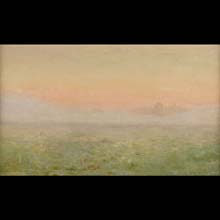
material: oil on canvas
dimensions: 52 × 74,5 cm
description: Chełmoński was famous for his extraordinary sense of observation and ability to perceive the most subtle effects of nature. In Dawn, the artist created a luminous colour impression devoted to the fleeting moment when night gives way to the brightness of day. A deeply emotional bond between the painter and nature emanates from the work, and the effect captured here acquires a symbolic significance. In accordance with the Romantic conviction about the presence of a spiritual element in nature, the artist empathizes with nature, becoming one with it. The vast expanse of an olive green meadow, with violet morning mists hanging over it, has been juxtaposed with a stretch of sky suffused with the golden pink hue of dawn. The synthetically rendered composition of the work painted en plein air is built up of horizontal parts of the painting intermingling slightly. The form is defined by delicately applied colour, with subtle, soft value transitions. The enchanting luminosity of the landscape reminds of the works of the Impressionists, while the mystical contemplation of the beauty of nature is connected with the pantheistic worship of the Creator identified with it. This way of representing nature, typical of Chełmoński’s late works, was compared to literary works by Adolf Dygasiński, Józef Weyssenhoff and Maria Rodziewiczówna, with whom the painter wandered through Podolia during the summer of 1906. Aleksandra Krypczyk
exposition: The Gallery of 19th Century Polish Art in Sukiennice,
The Cloth Hall, 1, Main Market Square
key: Realism, polish impressionism, beginnings of symbolism >>>
dimensions: 52 × 74,5 cm
description: Chełmoński was famous for his extraordinary sense of observation and ability to perceive the most subtle effects of nature. In Dawn, the artist created a luminous colour impression devoted to the fleeting moment when night gives way to the brightness of day. A deeply emotional bond between the painter and nature emanates from the work, and the effect captured here acquires a symbolic significance. In accordance with the Romantic conviction about the presence of a spiritual element in nature, the artist empathizes with nature, becoming one with it. The vast expanse of an olive green meadow, with violet morning mists hanging over it, has been juxtaposed with a stretch of sky suffused with the golden pink hue of dawn. The synthetically rendered composition of the work painted en plein air is built up of horizontal parts of the painting intermingling slightly. The form is defined by delicately applied colour, with subtle, soft value transitions. The enchanting luminosity of the landscape reminds of the works of the Impressionists, while the mystical contemplation of the beauty of nature is connected with the pantheistic worship of the Creator identified with it. This way of representing nature, typical of Chełmoński’s late works, was compared to literary works by Adolf Dygasiński, Józef Weyssenhoff and Maria Rodziewiczówna, with whom the painter wandered through Podolia during the summer of 1906. Aleksandra Krypczyk
exposition: The Gallery of 19th Century Polish Art in Sukiennice,
The Cloth Hall, 1, Main Market Square
key: Realism, polish impressionism, beginnings of symbolism >>>












